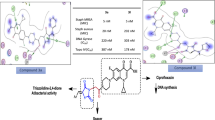Abstract
Antibiotics that are normally used to treat infections caused by Gram-positive bacteria might be made effective against Gram-negative bacterial infections, if they can circumvent permeability barriers and antibiotic deactivation processes associated with Gram-negative bacteria. Herein we report syntheses of bis-catechol–teicoplanin and mixed ligand catechol–hydroxamate–teicoplanin conjugates. Antibacterial activity assays revealed that conjugation of teicoplanin, which is only known to be active against Gram-positive bacteria, to the siderophore mimics induced potent activity against multidrug resistant strains of select Gram-negative bacteria (Acinetobacter baumannii) while retaining moderate activity against Gram-positive bacteria (Staphylococcus aureus).



Similar content being viewed by others
References
Cornelli C, Gallo GG, Cavalleri B. Teicoplanin: chemical, physico-chemical and biological aspects. Farm, Ed Sci. 1987;10:767–86.
Parenti F. Structure and mechanism of action of teicoplanin. J Hosp Infect. 1986;7 Suppl. A:79–83.
Kahne D, Leimkuhler C, Lu W, Walsh C. Glycopeptide and lipoglycopeptide antibiotics. Chem Rev. 2005;105:425–48.
Ravi T, Deepak K, Nayak J, Manish Kumar P, Prakash V. In-vitro activity of teicoplanin against clinical methicillinresistant Staphylococcus aureus isolates. J Microbiol Biotechnol. 2017;2:000112.
Arioli V, Pallanza R. Teicoplanin-resistant coagulase-negative staphylococci. Lancet. 1987;1:39.
Malabarba A, Trani A, Strazzolini P, Cietto G, Ferrari P, Tarzia G, Pallanza R, Berti M. Synthesis and biological properties of N63-carboxamides of teicoplanin antibiotics. Structure-activity relationships. J Med Chem. 1989;32:2450–60.
Szücs Z, Ostorhazi E, Kicsak M, Nagy L, Borbas A, Herczegh P. New semisynthetic teicoplanin derivatives have comparable in vitro activity to that of oritavancin against clinical isolates of VRE. J Antibiot. 2019;72:524–34.
Wencewicz TA, Miller MJ. Sideromycins as pathogen targeted antibiotics. Top Med Chem. 2017;26:151–184.
Hider RC, Kong X. Chemistry and biology of siderophores. Nat Prod Rep. 2010;27:637–57.
Kong H, Cheng W, Wei H, Yuan Y, Yang Z, Zhang X. An overview of recent progress in siderophore-antibitoic conjugates. Eur J Med Chem. 2019;18:111615.
Lin YM, Ghosh M, Miller PA, Möllmann U, Miller MJ. Synthetic sideromycins (skepticism and optimism): selective generation of either broad spectrum or narrow spectrum Gram-negative antibiotics. Biometals. 2019;32:425–51.
Ji C, Juarez-Hernandez RE, Miller MJ. Exploiting bacterial iron acquisition: siderophore conjugates. Future Med Chem. 2012;4:297–313.
Ghosh M, Miller PA, Möllmann U, Claypool WD, Schroeder VA, Wolter WR, Suckhow M, Yu H, Li S, Huang W, Zajicek J, Miller MJ. Targeted antibiotic delivery: selective siderophore conjugation with daptomycin confers potent activity against multi-drug resistant Acinetobacter baumannii both in vitro and in vivo. J Med Chem. 2017;60:4577–83.
Ghosh M, Lin YM, Miller PA, Möllmann U, Boggess WC, Miller MJ. Siderophore conjugates of daptomycin are potent inhibitors of carbapenem resistant strains of Acinetobacter baumannii. ACS Infect Dis. 2018;4:1529–35.
Liu R, Miller PA, Vakulenko SB, Stewart NK, Boggess WC, Miller MJ. A synthetic dual drug sideromycin induces gram-negative bacteria to commit suicide with a gram-positive antibiotic. J Med Chem. 2018;61:3845–54.
Braun NA, Ousmer M, Bray JD, Bouchu D, Peters K, Peters E-M, Ciufolini MA. New oxidative transformations of phenolic and indolic oxazolines: an avenue to useful azaspirocyclic building blocks. J Org Chem. 2000;65:4397–408.
Möllmann U, Heinisch L, Bauernfeind A, Kohler T, AnkelFuchs D. Siderophores as drug delivery agents: application of the “Trojan Horse” strategy. BioMetals. 2009;22:615–24.
Ghosh A, Ghosh M, Niu C, Malouin F, Möllmann U, Miller MJ. Iron transport-mediated drug delivery using mixed ligand siderophore-β-lactam conjugates. Chem Biol. 1996;3:1011–9.
Wencewicz TA, Miller MJ. Biscatecholate–monohydroxamate mixed ligand siderophore–carbacephalosporin conjugates are selective sideromycin antibiotics that target Acinetobacter baumannii. J Med Chem. 2013;56:4044–52.
Acknowledgements
We thank Hsiri Therapeutics for support of this research and B. Boggess and N. Sevov at the University of Notre Dame for LC/MS assistance and the University of Notre Dame NMR facility.
Author information
Authors and Affiliations
Corresponding author
Ethics declarations
Conflict of interest
The authors are employees of Hsiri Therapeutics and claim no other conflict of interest.
Additional information
Publisher’s note Springer Nature remains neutral with regard to jurisdictional claims in published maps and institutional affiliations.
Supplementary information
41429_2019_268_MOESM1_ESM.docx
Supplemental Material: Antibiotic Repurposing: Bis-catechol- and Mixed Ligand (Bis-catechol-mono-hydroxamate)-Teicoplanin Conjugates are Active against Multi-Drug Resistant Acinetobacter baumannii
Rights and permissions
About this article
Cite this article
Ghosh, M., Miller, P.A. & Miller, M.J. Antibiotic repurposing: bis-catechol- and mixed ligand (bis-catechol-mono-hydroxamate)-teicoplanin conjugates are active against multidrug resistant Acinetobacter baumannii. J Antibiot 73, 152–157 (2020). https://doi.org/10.1038/s41429-019-0268-7
Received:
Revised:
Accepted:
Published:
Issue Date:
DOI: https://doi.org/10.1038/s41429-019-0268-7
- Springer Japan KK




